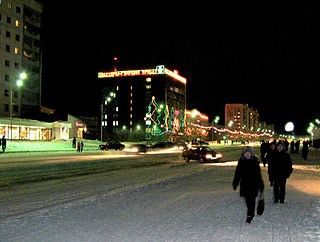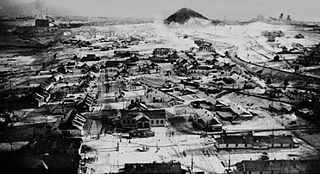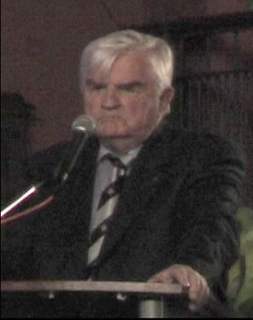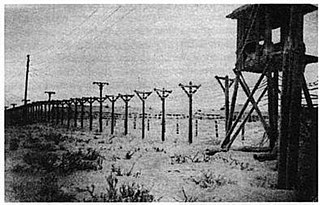Related Research Articles

The Gulag, GULAG, or GULag was the government agency in charge of the Soviet network of forced labor camps set up by order of Vladimir Lenin, reaching its peak during Joseph Stalin's rule from the 1930s to the early 1950s. English-language speakers also use the word gulag to refer to all forced-labor camps that existed in the Soviet Union, including camps that existed in the post-Lenin era.

Lavrentiy Pavlovich Beria was a Georgian Bolshevik and Soviet politician, Marshal of the Soviet Union and state security administrator, chief of the Soviet security, and chief of the People's Commissariat for Internal Affairs (NKVD) under Joseph Stalin during World War II, and promoted to deputy premier under Stalin from 1941. He later officially joined the Politburo in 1946.

Vorkuta is a coal-mining town in the Komi Republic, Russia, situated just north of the Arctic Circle in the Pechora coal basin at the river Vorkuta. Population: 70,548 (2010 Census); 84,917 (2002 Census); 115,646 (1989 Census).

Kolyma is a region located in the Russian Far East. It is bounded to the north by the East Siberian Sea and the Arctic Ocean, and by the Sea of Okhotsk to the south. The region gets its name from the Kolyma River and mountain system, parts of which were not accurately mapped by Russian surveyors until 1926. Today the region consists roughly of the Chukotka Autonomous Okrug and the Magadan Oblast.

Viktor Semyonovich Abakumov was a high-level Soviet security official from 1943 to 1946, the head of SMERSH in the USSR People's Commissariat of Defense, and from 1946 to 1951 Minister of State Security or MGB (ex-NKGB). He was removed from office and arrested in 1951 on fabricated charges of failing to investigate the Doctors' Plot. After the death of Joseph Stalin, Abakumov was tried for fabricating the Leningrad Affair, sentenced to death and executed in 1954.
Throughout the history of the Soviet Union, millions of people suffered political repression, which was an instrument of the state since the October Revolution. It culminated during the Stalin era, then declined, but it continued to exist during the "Khrushchev Thaw", followed by increased persecution of Soviet dissidents during the Brezhnev era, and it did not cease to exist until late in Mikhail Gorbachev's rule when it was ended in keeping with his policies of glasnost and perestroika.
Kengir is a village in central Kazakhstan. During the Soviet era, a prison labor camp of Steplag division of Gulag in Kazakhstan was set up adjacent to it. The camp, which was situated near the central-Kazakhstan city of Dzhezkazgan, near the Kara-Kengir River, and held approximately 5,200 prisoners, was the scene of a notable prisoner uprising in the summer of 1954. After the camp was closed, a large automotive depot was placed there.

Sergei Nikiforovich Kruglov was the Minister of Internal Affairs of the Soviet Union from December 1945 to March 1953 and again from June 1953 until January 1956. He held the military rank of Colonel General. He was involved in several brutal actions of the Soviet security forces. These actions occurred in the 1940s and were carried out alongside his comrade-in-arms General Ivan Serov.

The Vorkuta Uprising was a major uprising of forced labor camp inmates at the Vorkuta Gulag in Vorkuta, Russian SFSR, USSR from 19 July to 1 August 1953, shortly after the arrest of Lavrentiy Beria. The uprising was violently stopped by the camp administration after two weeks of bloodless standoff.

The 1,524 mm broad gauge Salekhard–Igarka Railway, also referred to variously as Dead Road , and Stalinbahn, is an incomplete railway in northern Siberia. The railway was a project of the Soviet Gulag system that took place from 1947 until Stalin's death in 1953. Construction was coordinated via two separate Gulag projects, the 501 Railroad beginning on the River Ob and 503 Railroad beginning on the River Yenisey, part of a grand design of Joseph Stalin to span a railroad across northern Siberia to reach the Soviet Union's easternmost territories.

John H. Noble was an American survivor of the Soviet Gulag system, who wrote two books which described his experiences in it after he was permitted to leave the Soviet Union and return to the United States.
Nikolay Nikolayevich Punin was a Russian art scholar and writer. He edited several magazines, such as Izobrazitelnoye Iskusstvo among others, and was also co-founder of the Department of Iconography in the State Russian Museum. Punin was a lifelong friend and common-law husband of poet Anna Akhmatova who is famous for writing the poem Requiem.
The Norilsk uprising was a major strike by Gulag inmates in Gorlag, a special camp mostly for political prisoners, and later in the two camps of Norillag [ITL], Norilsk, USSR, now Russia, in the summer of 1953, shortly after Joseph Stalin's death. About 70% of inmates were Ukrainians, some of whom had been sentenced for 25 years because of KGB accusations of being involved in the "Bandera standard", however the KGB was notorious for giving false accusations. It was the first major revolt within the Gulag system in 1953–1954, although earlier numerous cases of unrest in Gulag camps are known. It was led by Pavel Frenkiel in 1 camp, by Boris Shamaev in 3-d camp, by Yevhen Hrytsyak in 4-th camp, by Pavel Filnev in 5-th camp and by Lesya Zelenska in 6-th camp.

The Vorkuta Corrective Labor Camp, commonly known as the Vorkuta Gulag or Vorkutlag (Воркутлаг), was a major GULAG labor camp of the Soviet Union located in Vorkuta from 1932 to 1962.
The Vorkuta State Drama Theatre is located in the Russian city Vorkuta. It was opened in 1943 in the Gulag.

Jānis Mendriks was a Latvian Catholic priest killed in the Vorkuta Uprising in the Soviet Gulags.
The People's Commissariat for Internal Affairs, abbreviated NKVD, was the interior ministry of the Soviet Union.
De-Stalinization consisted of a series of political reforms in the Soviet Union after the death of long-time leader Joseph Stalin in 1953, and the ascension of Nikita Khrushchev to power.
Siberian Ukrainians, form a national minority in Siberia and the Russian Far East, but make up the majority in some cities there. Siberian Ukrainians, one of the largest and historically important constituent parts of the Ukrainian diaspora, represent one of the first Ukrainian diasporas.

Estimates of the number of deaths attributable to the Soviet dictator Joseph Stalin vary widely. The scholarly consensus affirms that archival materials declassified in 1991 contain irrefutable data far superior to sources used prior to 1991 such as statements from emigres and other informants, whereas a minority of authors and journalists maintain that "statistics can never fully describe what happened".
References
- ↑ Lynne Viola (2007). The Unknown Gulag: The Lost World of Stalin's Special Settlements. Oxford University Press (2007). p. 126f. ISBN 978-0-19-518769-4.
- 1 2 3 4 Nikolai Tolstoy (1982). Stalin's Secret War. Holt, Rinehart and Winston (1981). p. 357. ISBN 0-03-047266-0.
- ↑ Gulag Archipelago , Vol. 3